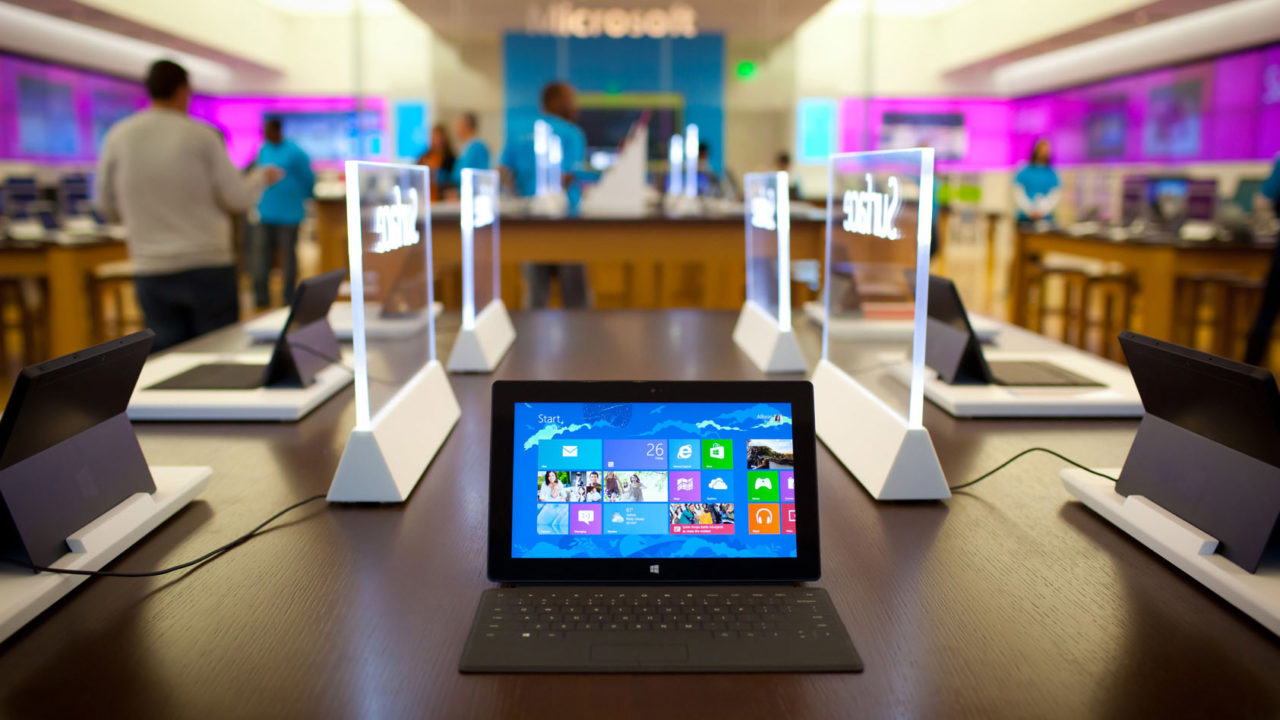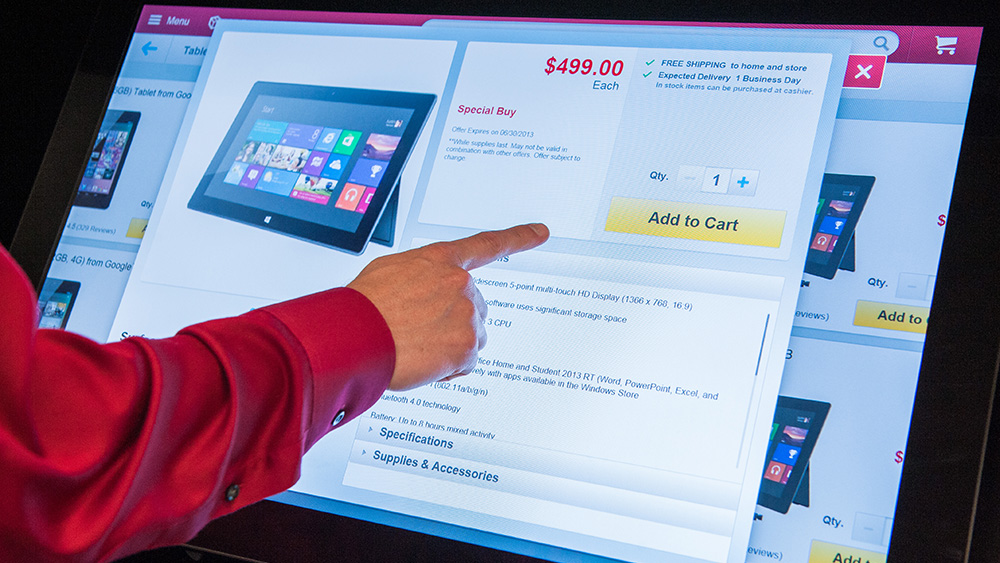In Defense of the Microsoft Surface

To say that the Microsoft Surface has failed to live up to the company’s expectations is an understatement. After poor sales led to a staggering $900 million write-down last summer ( cough, I mean “inventory adjustment”), the second generation of the product has fared only marginally better in terms of sales. But longtime Apple fans know that there’s far more to a product’s merits than sales figures – a fact that’s easy to forget now that the company is dominant in many of the product categories in which it competes – so I was quite perplexed upon reading John Martellaro’s brief blog entry Monday at The Mac Observer, in which he posits that the “complexity” of the Microsoft mobile ecosystem leads to remorseful customers. In short, I think his characterization of the situation is clearly off the mark.
A friend and colleague, Mr. Martellaro consistently approaches his topics with thoughtfulness and fairness, a rarity in today’s link-bait-obsessed technology press. I therefore read his blog entry with eagerness. He tells the tale of a family he and his wife encountered while shopping at Staples: a mother, father, and daughter about to head off to college.
The father had apparently recently purchased an ARM-based Microsoft Surface device (Mr. Martellaro calls it the “Surface RT” but the timing of the event makes it unclear if the product in question was a first-generation Surface RT or its successor, the Surface 2). Unfortunately, the family was forced to return to the store after discovering that the Surface wouldn’t run the daughter’s existing x86 applications.

In-Store Kiosk/Staples
It’s a clear limitation of any ARM-based product: absent some form of emulation, ARM tablets and phones cannot execute x86 binaries. In the Microsoft world, the company addresses this limitation by offering two separate product lines, the Surface 2 and the Surface Pro 2. The former is ARM-based while the latter has a full-blown x86 Haswell architecture, and is compatible with the complete range of modern desktop applications.
As Mr. Martellaro describes the situation, the family was apparently given incorrect information when purchasing the ARM-based Surface. The daughter was counting on the capability to run her existing desktop applications, and the ARM-based Surface wasn’t going to cut it. Okay, I’m on board with the story up to this point, but here’s where I disagree with Mr. Martellaro.
Right away, I thought about how complexity is the devious manufacturer’s friend. Complexity, clever price points, and the right kind of advertising can convince the uninformed buyer that the solution is painless and inexpensive — when it really isn’t.
I agree, in principle, with Mr. Martellaro’s assessment. But I don’t see how it applies to the Surface, which is a relatively defined and easy-to-understand product category. The problem here isn’t Microsoft’s supposed complexity, it’s a retail salesperson who didn’t know what he or she was talking about.
Of all the products that Microsoft has ever released, the Surface line is relatively straightforward
As mentioned earlier, aside from capacity differences, the Surface line currently consists of two products: Surface 2 and Surface Pro 2 (although you can still pick up the original Surface RT for a discount, as Microsoft attempts to clear unsold inventory). The difference between these products is their architecture, either ARM or Intel (x86). If you want a true tablet that runs touch-focused apps, you go with Surface 2. If you want both a tablet and the ability to run existing Windows apps, you pick up a Surface Pro 2.
Microsoft has been quite clear about this distinction, both with clearly labeled technical specifications for those who know the difference between ARM and Intel, as well as with more mainstream-focused language, such as the Surface Pro 2 is a “tablet that can replace your laptop” and is “compatible with all your favorite Windows software.”
Far from complex, this simple choice is one small area where Microsoft has an advantage over its Cupertino rival. The Surface Pro 2 can’t be compared to an iPad, or other ARM-based tablet. It’s truly a competitor for the MacBook Air and third-party Windows-based Ultrabooks, but with a huge benefit: it functions as a tablet when you want it to, but quickly and easily converts into a full-fledged laptop when you need it, complete with mouse support.
It’s certainly possible that customers armed with incorrect information could mistake the Surface Pro 2’s capabilities for those of the Surface 2, but so, too, could novice Apple customers confuse iOS and OS X, which is exactly what I saw on occasion while working for the company. Whether it was a customer pawing at an iMac screen as if it were a touch screen, or an inappropriately angry lady who stormed into the store one day, screaming at me because she was under the false impression that her new iPad could run the accounting software she’d used on her Mac for years, customers sometimes receive bad information, regardless of how “complex” a company’s product line is perceived to be. Yes, a highly complex product line will facilitate higher incidences of angry customers, but of all the products that Microsoft has ever released, the Surface line is relatively straightforward.

dotshock/Shutterstock
Further, it’s clear to me at this point that Apple is on a path that will someday see the merger of what we now know as iOS and OS X. Likely introduced in phases, it’s unclear if we’ll first see an iPad-like device running a future version of OS X, or a MacBook Air-like device running a future version of iOS, but I’m betting we’ll get at least one in the next few product cycles. In either case, such a move would introduce the exact same scenario that Mr. Martellaro now labels as problematic for Microsoft, but I doubt that many will view this move as an unnecessary increase in the complexity of Apple’s product line.
“Complexity” isn’t the issue here, just bad information
New technologies often require customers to abandon their existing platforms. Although Microsoft has traditionally been much better about backwards compatibility than Apple, the move to mobile computing is the introduction of a new world. Neither Mr. Martellaro nor myself bemoaned the introduction of iOS as unnecessary complexity, and we expected Apple’s customers to understand that their OS X software wouldn’t run on Apple’s new devices (which is not as clear-cut to novices as it seems, as Apple now markets software for both iOS and OS X as simply “apps”).
Mr. Martellaro also notes that “any kind of good solution to this family’s problem is going to cost serious money,” but I fail to see how that’s a knock against Microsoft or the company’s “ecosphere.” The daughter in this tale had an old Windows-based laptop that was in need of replacement. Buying a new computing device is going to cost anyone money, regardless of whether the “ecosphere” is Apple’s, Microsoft’s, or anyone else’s.
Flipping the situation for a moment, if the daughter had an old 2006 MacBook and wanted to buy a new Apple device that could run her existing apps, her cheapest option would be a $1,000 11-inch MacBook Air. There are many Windows-based devices, including the Surface Pro 2, that are at or below that price point.
If a customer wants a Windows laptop, they should buy a Windows laptop. If they want a Windows tablet, they need only ask themselves if they want to preserve compatibility with existing desktop apps. The answer to that question will direct their choice, and the same calculation applies to Apple.
Microsoft’s Surface is certainly far from perfect, and customers may still feel “buyer’s remorse” based on their personal experience with the device. But “complexity” isn’t the issue here. The family that Mr. Martellaro encountered had simply been fed bad information, and that’s something that can happen to any consumer, in any store, with any company’s product.

















4 thoughts on “In Defense of the Microsoft Surface”
The entire UI was designed to look the same as windows full-edition, so people think they are getting a 400$ device that is both a tablet and a computer. Additionally, using “Pro” to differentiate products which are completely different is not appropriate, especially considering Microsoft’s own conventions. As an example windows 7 Home and Windows 7 Pro are almost the same product.
I’m not convinced by your example of 1 apple customer. By and large people know they are buying an iPad, and they know it is not a computer. If they don’t, the name doesn’t try to confuse them. A iMac is not an iPad pro, and an iPad is not a Mac RT. There’s a clear distinction, and the homescreen is comepletely different.
Microsoft has NOT clearly delineated their products and its led to MASSIVE consumer confusion. The end.
It’s the same exact question Apple buyers ask. If you want to run an OS X app, you won’t buy an iPad (or iPhone). But some Apple customers (I’ve personally seen the aftermath of this on multiple occasions) get bad information and end up buying iOS devices when what they really needed was a Mac, or vice versa. I was just talking to a lady at the supermarket yesterday who was upset that her new MacBook Air, which she bought at Best Buy (we don’t have an Apple Retail Store in town – I hope she would have received better info there) wouldn’t play “that Crush Candy game” her daughter told her about. It happens.
The decision should be intuitive. You may argue all you want that Microsoft’s product selection is easy to understand but the facts and the reaction of consumers will shout you down.
I appreciate your enthusiasm, but you are demonstrably incorrect. Perhaps you didn’t read my entire article, but I personally dealt with an Apple customer who returned to the store, angry, after being sold an iPad and later discovering that it wouldn’t run her Mac apps. (I also humorously received a phone call one day asking “where the CD drive was” on an iPad).
You are obviously up-to-date with technology, and easily understand the distinctions between the product lines. But as Apple sells tens of millions of products every quarter, larger and larger numbers of “average” people join the family. They don’t understand, or care to understand, x86 versus ARM, OS X versus iOS. They view it as simply “Apple,” and they rely on others to inform their purchasing decisions. By your own definition, the fact that some Apple customers were confused points to a failure by Apple. I’m not arguing that, and neither, I think, would you. But by extension, it’s not product confusion that is the Surface’s problem, just because some customers are indeed confused after receiving bad information.
Here, however, the family in question bought the Surface at Staples, and I have no trouble believing that a salesperson at a third party retailer would lack the training to provide even basic information on the computing devices they sell.
Thanks for the comment, but I cannot agree that “bad information = complexity” and vice versa. If the threshold is set that low, then practically every company in every product category is doing it wrong, including Apple. As I mentioned, I have personally seen Apple customers get the wrong information (either from a misinformed employee or from their own faulty research). Apple customers have unquestionably returned to the store, angry and confused that their new product didn’t meet their needs. While this is less likely at an Apple Retail Store (or a Microsoft Store on the other side of the equation) as opposed to a third party retailer, it still happens.
Even Apple’s current lineup is quite complex. Including carrier differences, there are 84 different models of iPhone in the U.S. alone. While the differences between current iPhones are for the most part not as dramatic as Surface vs Surface Pro (mostly just capacity/color/carrier), that’s not entirely the case, particularly with the iPhone 4S, iPad 2, and first-gen iPad mini. These older devices, still sold by Apple, can’t perform key iOS 7 functions: http://blog.laptopmag.com/ios-7-compatibility-infographic I doubt very much that average Apple Store specialists and their third party counterparts know all of these limitations and present them accurately to customers. I’ve repeatedly seen these products positioned primarily as the “cheaper” choice, with only the obvious differences explained (such as the lack of a Retina screen and overall screen size).
I also think that while Windows RT makes little sense now, its introduction in 2012 was not just to compete with Apple. Intel’s mobile offering at the time didn’t provide the battery life that was expected of a consumer tablet, and so Microsoft needed an alternative. I personally think they should have just brought Windows Phone OS to the tablet, but Windows RT gave them the flexibility to include the full-blown Office and a unified experience across both tablets. And for customers who understand the difference (which is pretty straightforward, as I discuss in the article), the Windows RT Surface devices are compelling. I’ve used both the Surface 2 and Surface Pro (not yet the Pro 2), and the RT does a competent job. I have the tablet interface when I want it, but the desktop and its multitasking benefits when I need it. Intel is gearing up to deliver much better x86 mobile performance and power efficiency, so we may indeed see future Surface lines comprised entirely of x86 devices, but Windows RT was an easy way to get a relatively thin and light device with decent battery life, not just a play to compete with Apple.
It’s totally understandable to be disappointed with Surface for other reasons but, seriously, it’s one of the least complicated things Microsoft has ever done. Microsoft’s Windows 7 editions were complex, Apple’s computer lineup in the 1990s was complex, but Surface just isn’t.
I am writing this on my Surface 2, and if the surface 2 was never released, I would not be using skydrive every day, I would not have my subscription to MS office (I would have continued using a pirated copy or something, sorry MS), and I probably wouldn’t have bought an Xbox One. I’d probably be using a competitor’s tablet. Oh and I would probably be using iTunes or something instead of Xbox Music, which I now have a subscription to, and really enjoy. I tried using Xbox Music because apple refuses to make a iTunes app for windows 8. Its actually really good, like Spotify but better. I am so glad I gave it a chance.